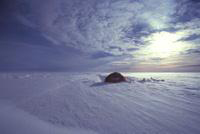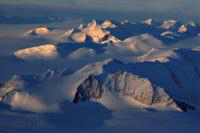
|
| |
| Vinson Massif Expedition » |
| |
| The Vinson expedition in Antarctica will leave from Punte Arenas in Chile and a 4.5 hour flight will bring us to our camp side Patriot Hills, as this area is only accessible by air. Patriot Hills is nestled within the heartland of Antarctica. The camp is at 80º 19' south latitude and 81º 16' west longitude, 1000m above sea level and 1076km from the South Pole. |
| |
The Environment
 Antarctica is the coldest, windiest, driest continent on the planet. The weather, strong winds and brutal storms have been synonymous with Antarctica since its discovery and continue to be a major challenge for modern explorers. Most of the early diaries and tales of exploration of Antarctica are filled with stories of how the weather was man's biggest enemy on the continent. Nature's power is seldom seen as ferocious as it is in Antarctica, making this one of the most inhospitable places on earth.
Antarctica is the coldest, windiest, driest continent on the planet. The weather, strong winds and brutal storms have been synonymous with Antarctica since its discovery and continue to be a major challenge for modern explorers. Most of the early diaries and tales of exploration of Antarctica are filled with stories of how the weather was man's biggest enemy on the continent. Nature's power is seldom seen as ferocious as it is in Antarctica, making this one of the most inhospitable places on earth.
In the winter, the lowest recorded temperatures (without wind chill!) have reached -89°C (-129°F). The continent averages 2.4 km in height (1.5 miles) above sea level, making it 1.5 km (almost a mile) higher than the global average land height! Each year the South Pole receives less than an inch of water... in the form of snow, of course! This amount of precipitation is similar to that of another desert, the Sahara! Katabatic winds, reaching 300 km per hour (185 miles/hour), blow out of the continental interior and make the Antarctic coastal regions rather breezy.
|
| |
The Continent
- Antarctica is the Earth's 5th largest continent, measuring 14 million square km (5.4 million square miles).
- The ice sheet that covers almost all of Antarctica is the largest body of fresh water on earth, containing about 91% of the world's ice and 70% of the fresh water.
- If Antarctica's ice sheet were to melt, it would raise the level of the world's oceans about 70m (200 ft).
- The thickest part of the ice sheet extends about 4,800km (2980nm) (15,700 ft) into submerged basins in the rock.
- Antarctica has the greatest average elevation of any continent at 1,860m (6,100 ft). The average elevation of North America is 720m (2,300 ft).
- The highest mountain on the continent is Vinson Massif, 4,897m (16,067 ft), situated in the Ellsworth Mountains.
|
 |
|
| |
Itinerary
- Arrival in Punta Arenas
- Flight Preparations
- Day 1 - Departure for Antarctica
- Days 2-3 - Acclimatization, Vinson Base - Our first 1-2 days will be spent near Vinson base with an ascent of one of the peaks in the area. This will give us a chance to acclimatize and practice climbing as a team so that we are strong and efficient when we tackle the main summit.
- Vinson Base to Low Camp - 2300 ft (700 m) of elevation gain, 5 1/2 miles (9 km) of distance, 4-6 hours travel.
- Low Camp to High Camp - 3900 ft (1200 m) of elevation gain, fixed ropes on slopes up to 45°, approximately 6-8 hours travel.
- High Camp to Vinson Summit – Return trip from High Camp. Summit day is our longest day of travel — 300 ft (900 m) elevation gain, 9 miles (14 km) distance, 9-12 hours travel.
- Descent to Vinson Base and Return to Patriot Hills - The descent to Vinson Base is usually achieved in one day from High Camp, re-tracing our route down the fixed ropes and along the Branscomb Glacier.
- Return to Punta Arenas - Weather permitting, the aircraft from Punta Arenas will arrive in Patriot Hills on the scheduled departure day.
|
| |
|
 |
|
|
| |
|

